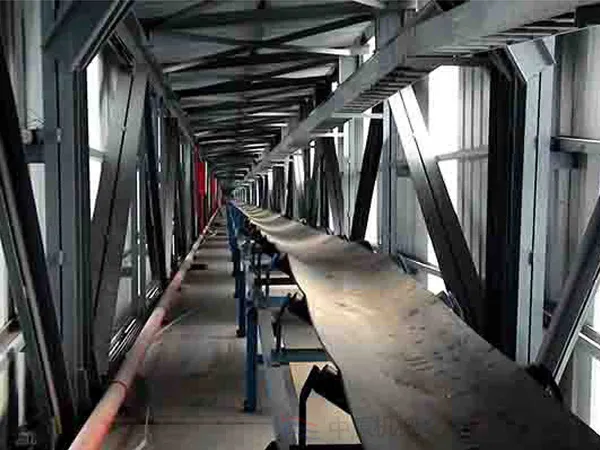

-
Products
-
Application


Belt conveyor deflection, also known as mistracking or misalignment, is a common issue that can lead to increased wear on components, material spillage, and costly downtime. Adjusting it effectively requires understanding the causes and applying the appropriate solutions.

Misaligned support structures, pulleys (head, tail, drive, snub), and idlers.
Non-perpendicularity of roller axes to the belt's centerline.
Skewed conveyor frame.
Incorrect belt splicing (not straight or uneven tension).
Operational Issues:
Uneven or off-center material loading.
Material build-up on pulleys, idlers, or the belt itself.
Insufficient or uneven belt tension.
Seized, worn, or damaged rollers/idlers.
Worn or damaged belt (e.g., uneven wear, aging deformation, edge damage).
Foreign objects stuck in the system.
Environmental factors (e.g., wind).
Vibration during operation.
Start with a clean conveyor: Remove any material buildup from rollers, pulleys, and the belt.
Conduct adjustments during no-load operation: This allows for clear observation of the belt's natural tracking.
Adjust gradually and one side at a time: Small adjustments are key to avoiding overcorrection.
Work from the head/discharge end backwards: Often, issues at the head end can cause problems further down the line.
Allow time for the belt to react: After an adjustment, let the belt run for several minutes (at least 4-5 full belt revolutions) to see the effect before making further changes.
Confirm with a load: Once the belt tracks well under no-load, test it with a load to ensure continued stability.
Adjusting Idlers (Rollers):
Leveling: Ensure all idlers are perfectly horizontal and parallel to each other, and perpendicular to the conveyor's direction of travel. Use a carpenter's level for accuracy.
Skewing (for straight runs): If the belt consistently drifts to one side, you can slightly skew the idlers in the opposite direction of the drift. For example, if the belt runs to the left, move the idlers slightly forward on the right side (or backward on the left side) to steer it back to the center. Make very small adjustments.
Self-aligning idlers/training idlers: These are designed to automatically correct minor belt deviations. They have pivot mechanisms that cause the idler to rotate when the belt moves off-center, guiding it back.
Boosting Bracket/Pad Height Adjustment: If an idling belt consistently deviates to one side, you can slightly raise the idler on the opposite side of the deviation. This helps "steer" the belt back to the center.
Vertical Rollers: For persistent one-sided deviation, vertical rollers can be installed on the deviation side to forcibly reset the belt and reduce its linear speed on that side, encouraging it to move back.
Adjusting Pulleys (Head, Tail, Drive, Snub):
Horizontal Adjustment: If the belt deviates at a drum, it might indicate horizontal movement of the drum or an installation error. Correct the levelness and parallelism of the drums.
Cleanliness: Material buildup on pulleys can change their effective diameter, causing deflection. Regularly clean pulleys.
Lagging: Worn or damaged pulley lagging can lead to slippage and deflection. Inspect and replace lagging as needed.
Parallelism and Perpendicularity: Ensure all pulleys are parallel to each other and perpendicular to the conveyor's centerline. Use a tape measure or laser alignment tool to check distances from reference lines.
Insufficient Tension: If the belt is too loose, it can wander left and right without a fixed direction, especially under load. Adjust the tensioning device (e.g., take-up screws, winch, hydraulic system) to tighten the belt.
Excessive Tension: While increasing tension can help with slippage, too much tension can damage the belt splice, bearings, and other components. Use a tension meter to ensure the tension is within manufacturer specifications. Ensure tension is even across the belt's width.
Addressing Material Loading:
Centering: Ensure material is loaded onto the center of the belt. Off-center loading is a major cause of deflection, especially on the carrying side. Adjust chutes and loading points to ensure even distribution.
Drop Point: The position and angle of material dropping onto the belt can significantly impact tracking. Optimize the design of transfer points.
Belt Condition and Splicing:
Belt Quality: An aged, deformed, or damaged belt can cause consistent deflection. Inspect the belt for wear, cuts, or unevenness.
Splice Integrity: A poorly made splice (not straight or with uneven tension) will cause the belt to deviate, often with the maximum deflection occurring at the splice. If necessary, re-splice the belt correctly, ensuring the joint is perpendicular to the belt's centerline.
Conveyor Structure and Frame:
Level and Square: The entire conveyor frame and support structures must be level and square. Any twist or misalignment in the frame will lead to consistent belt deflection.
Regular Inspections: Routinely check the belt, pulleys, idlers, and conveyor frame for wear, damage, and material buildup.
Cleaning Program: Implement a consistent cleaning schedule to prevent material accumulation.
Proper Lubrication: Ensure all rotating parts (bearings) are properly lubricated to prevent seizing.
Employee Training: Train operators and maintenance personnel on proper conveyor operation, adjustment techniques, and safety protocols.
Manufacturer Guidelines: Always refer to the conveyor manufacturer's specific recommendations for installation, tension, and maintenance.
By systematically identifying the root cause of the deflection and applying the appropriate adjustment methods, you can significantly improve the performance, lifespan, and safety of your belt conveyor system.

Official Agent of ZY MINING in Russia.
Please enter here.
Add: Luoxin Industrial Zone,Luoyang City,Henan Province P.R.C.
Tel: +86-379-67313306
E-mail: gloria@zyksjx.com